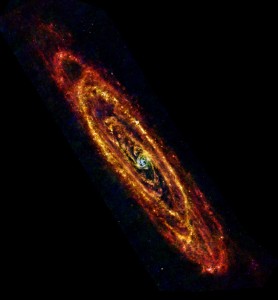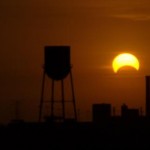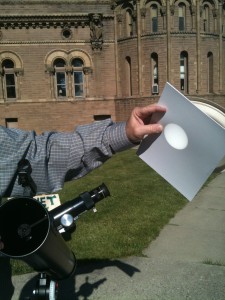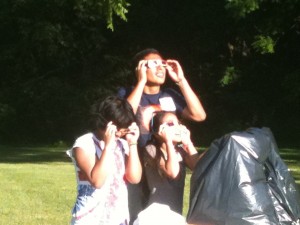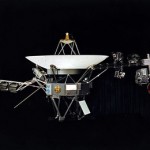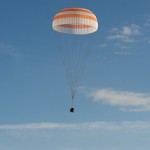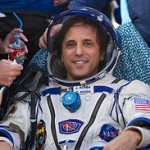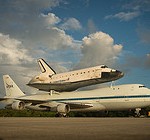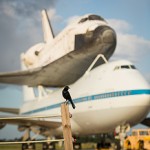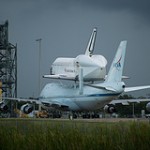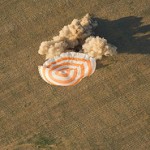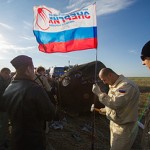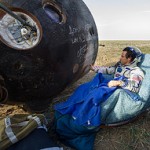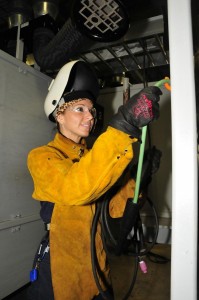The Cost of Seeing the Universe
I have always had a fondness of looking at images of stars, galaxies, and planets. In 2003, when I began working as the lead technology instructor for the Saturday Academy for Space Science at Chicago State University, I remember how amazed I was to see so many beautiful images of objects in the Universe that had been taken by the Hubble Telescope and then those that we and the students took with telescopes that are linked to the Hands-on-Universe project. Hearing the news Monday that the Herschel space observatory had closed its eyes for good filled me with sadness. While I had always been in love with the stars, the years I spent teaching in SASS solidified the awe I felt every time I looked up to the sky and saw the Milky Way. I became an amateur astronomer without realizing it and for the last ten years I have been drawn into the magic of using telescopes to see things that lie far, far, away from Earth.
When the Herschel space observatory was launched in May of 2008, its telescope and instrumentation allowed us to see the Universe in far-infrared light and gathered over 35,000 images, some as distant as the Andromeda Galaxy which lies 2.5 million light years from our Milky Way, since it began surveying the heavens. A project of ESA’s European Space Astronomy Centre, with heavy support from NASA, Herschel’s cost to date is 1.4 billion. With the current state of the government sequestration and people who remain vocal that this amount of money could be better spent on programs here on Earth, the depletion of the liquid helium that kept the instruments at a temperature near absolute zero has run out. Seeing far away has far reaching requirements and as there was no way to do a liquid helium re-supply mission to Herschel it was inevitable that the mission would end. For nearly five years, Herschel has allowed us to see stars being born, galactic dust, the Orion Nebula as never seen before, and a host of galaxies near and far from us.
While the mission has ended, the science and discoveries we will glean from the images will allow us to continue to unlock the secrets and mysteries of the Universe. Let us all take a moment the next time we look up to the sky and thank the eyes of the Herschel space observatory for five years of letting us see the Universe through its eyes.
Bon Voyage!
We <3 Robots
We build robots! We love them and they love us! FRC Team 2725, The Ice Princesses, are recruiting new members for the team. The Museum of Science & Industry’s Robot Block Party is the cool place to be Sunday, April 14. We’ll there with our 2013 robot, Sparkle! Stop by, say hello, and learn how girls build incredible robots!
In 2012 we said goodbye to Sally Ride, the first woman in space and as we bring 2012 to an end I could see no better way to end it than with this tour of the International Space Station with Expedition 33 commander, Suni Williams. Williams led the Expedition 33 mission and performed three spacewalks with fellow astronaut Akihiko Hoshide. Williams holds the record holder for a female astronaut with the most time logged in spacewalks. Girls around the world as you watch her tour the ISS, may you all be inspired to one day look down on the Earth from the Cupola of the ISS or from a space craft that will have humans going to the ISS and beyond. The tour is not only informative about the ISS and how astronauts live and work there, but she shares some interesting personal anecdotes as well. She loves Fluffernutters!
Christmas Presents from the Solar System!
Merry Christmas! This time of year is always nostalgic for me and I love the spirit of what the Christmas Season means more than the material side that has us flocking to malls, online sites, jewelry stores, and even car dealerships to find the perfect present for everyone on our Christmas list. My grandmother was born on December 25th and celebrating her birthday on Christmas day always was an extra special gift for me.
As I thought about my best Christmases and the gifts I cherished the most while growing up, I seemed to come back time and time again to the microscope set my father gave me one year and the 1954 American Flyer Train that always found its way under our Christmas Tree every December. The microscope was a gift that helped confirm my dream that one day I would be a doctor and learning how to use it and see the wonders of things too small to view with the naked eye. This would begin my path of learning towards a career in medicine. The train made no connections in my mind with transportation or engineering, either electrical or mechanical, I just thought it was cool. My mother, on the other hand, thought both gifts were for boys and couldn’t wrap her mind around what would motivate my father to give me a microscope that had me pricking my finger over and over and looking at my own cells for hours or a train no less that required me to put lengths of track together and sit on the floor to operate the transformer that powered the train on its course.
Now that I am immersed in science and creating programs to inspire more girls to develop a love for science, I think about how our perceptions on gender affect whether girls are steered towards math and science or deflected away from it. My mother thought I should be given dolls and Easy Bake Ovens. My father, whether he was aware or not, supported my dream of doing science. I didn’t get bit by the science bug at school but by reading and going to The Museum of Science and Industry and making trips with my grandmother to Dr. Prince’s office on Cottage Grove Avenue. Dr. Prince wore a white lab coat and to get to his examination room you had to go through his office. It was the most disorganized place I’d ever seen and I think in some ways I wanted to be a doctor so I could treat people in an office that was neat, organized, and promoted healing. He had a large leather sofa in his office that I remember after being examined or waiting for my grandmother I would sit on and watch the elevated trains go by.
A little girl with a big dream. That was me and while I let that dream go in college I never stopped loving science. Today as I go around and share the wonders of the Solar System, engineering projects and competitions, math challenges, environmental awareness, etc. I look in the faces of students and I often see my dreams reflected in their eyes. We have more tools, more access, and a greater push towards diversity today than we had four decades ago. Opportunities for girls as well boys, all populations that are underrepresented and under-served in STEM, are all around us. This Christmas I thought I would share some of the gifts that have come my way this year with all of my students, colleagues, friends, parents, and everyone who shares a love of science and looking to the skies.
Peace and Love to you all and have a very Merry Christmas and a Happy New Year!
The 2011 Lunar Eclipse was technically at the end of last year, but it was spectacular nonetheless. The pictures were taken by a friend of mine who works at the planetarium in Tokyo and hosts the monthly Liveshows of the night sky at Yerkes Observatory with my friend and colleague Vivian Hoette. This eclipse happened one day before my mother’s birthday. Her light, just as that reflected from the Moon, continues to shine on us all!
Annular Eclipse
This was a strikingly beautiful event on May 20th, 2012. I watched from my computer and telescopes from Slew.com. An annular eclipse occurs when the moon blocks out the center of the sun, leaving a glowing ring called an annulus around the moon’s dark silhouette. The glow from the ring was referred to by many media outlets as a “Ring of Fire.”
The Transit of Venus
All eyes were focused on the sky on June 5, 2012 as Venus made her transit across our Sun. It was an event that none of us will ever see again in our lifetime making it one of the truly once-in-a-lifetime events. I spent the day on the lawn of Yerkes Observatory in my volunteer role as a NASA Solar System Ambassador as well as a Stars@Yerkes Teacher Leader and assisted visitors in viewing Venus through sunscopes, solar viewing glasses, and some pretty low-tech ways to watch the transit as well. Inside there was live telescope viewing thanks to the Yerkes connection to a network of telescopes around the world. If you missed it or just want to experience it again, enjoy!
What Lies Beyond?
On September 10, 2012, Voyager 1 left our Solar system. Passing Jupiter in 1979 on a mission to explore the outer planets, Voyager 1 is the farthest man-made object in space. It is still transmitting data and scientists are learning more about our Heliosphere as
Voyager continues its journey in space.
The Mayan Calendar ends Dec 21, 2012: Thus So Does the World?
Well the predictions from doomsayers that the world would come to an end on December 21, 2012 proved that we lived another day and will live many more to come. Yes, the Mayan’s were great
astronomers and what they left behind for us to try and figure out has shed an understanding that we as humans have always had a link to the heavens regardless of what culture we belong to. As so many of my students were talking about the end of the world, I thought it would be a good project for them to do some authentic research to see if any of the predictions including Earth burning up from a gigantic solar flare to the galactic alignment could hold any truth. When they discovered that it looked like we’d be here on Friday, Dec. 21th, the surrounding veil of impending doom lifted and they could then tell other students, “No, the world will not end on December 21st, but……..”
They learned too how the Sun actually looks thanks to NASA’s Solar Dynamics Observatory and I don’t think they will ever look at the Sun in the same way again and they also learned about the Winter Equinox which really did occur on December 21st!Yes, they learned that a giant asteroid, Apophis, which is big enough to cause planetary extinction of all life as we know it, is heading towards Earth but it will be several years before we have to worry and hopefully if its trajectory stays course with Earth, some brilliant mind will have figured out a way to blow it up or deflect it by then. My son keeps saying that Earth needs a Superman.
There were the meteor showers too that delight us every year and will be back in 2013. And all doomsayers aside, we did have our own share of natural tragedies with multiple tornadoes in the Midwest during the spring, unprecedented heat across all of the United States this summer, and the devastation and destruction of hurricane Sandy in November. Despite all of this, we are resilient. As I sit here writing this, a gentle snow is finally falling outside. More lake effect than the storms that are traveling East and a pavement void of at least 6″ of snow in Chicago in December is just about unheard of.
So in 2013, keep your heads to the sky and marvel in the presents our Solar System gives us free of charge and do one inspiring thing everyday for you never know whose life you may change by just being you!
What a Sun!
Camilla SDO posted this fantastic video about the Sun.
We’re Back……..
Tonight SpaceX successfully launched its Dragon spacecraft on a Falcon 9 rocket on its first official resupply mission to the International Space Station. 8:35 pm EDT was lift-off and the Falcon 9 exhibited a beautiful launch against the night sky. In addition to materials, supplies, and space station hardware being carried to the Expedition 33 crew, twenty three student experiments, SSEP Antares and Aquarius II Experiments Payloads Integrated into Dragon Vehicle, were on board.
Our Teachers In Space group had the wonderful opportunity to meet Jeff Goldstein this summer and we all now have the opportunity to propose a student experiment that will fly to the ISS on the next SSEP mission. This is an exciting time for SpaceX, NASA, and all of us around the world at this is the second wave and the future of space technologies and space experimentation/exploration. It is exciting, exhilarating, and full of opportunity.
Makes me smile remembering visiting SpaceX’s corporate headquarters during the STS-133 Tweetup
Busy Day for NASA
Everyday there are many events happening in space, on Earth, and with the development of the new commercial space program but seldom are there two major events that garner as much attention as these two. The Space Shuttle Endeavor prepares to head to LA to her new home at the California Science Center and the Expedition 32 International Space Station crew returned safely home. Enjoy the images all courtesy of NASA’s Flickr photo stream.
Community Colleges Role in 21st Century STEM
Going over my teaching certificate and looking at the new requirements of the State of Illinois for K-12 educators, credit earned at the community college level is not accepted towards an endorsement. When this story came across my RSS feed, it affirmed my thoughts of the perception some people, and obviously state education boards, have about the quality of knowledge or skill a student attains in a community college course versus the same course in a four-year university. The idea that community college courses aren’t rigorous enough or the curriculum is watered down or the expectations and grading are much easier is a huge misconception.
So it was a pleasure to see Amber Gell, NASA Aerospace Scientist, working on her welding skills. She is enrolled in a welding program at San Jacinto College and working towards an associates degree in welding. Gell currently holds two bachelor’s degrees in aerospace engineering and aerospace studies, a master’s degree in physiology and human performance, and a graduate certificate in space systems engineering. She’s also working on a Master of Business Administration. In her own words, “I need to know about the actual work that goes into this,” said Gell. “Here in welding, it’s back to square one. Here, I’m one of the guys, not a scientist. I need to know how to identify a good weld.” She was principal investigator for NASA’s research in exothermic welding in a reduced gravity environment and understands the importance of being able to make repairs to space craft or even build habitats on Mars. In order to do this however, scientists will have to know how welding will work in a reduced gravity environment so Gell’s hands-on work in class is assisting her in her research. Read the entire article on Gell and her research.Many technical programs that once existed in high schools have been eliminated over the past ten or more years as the new education focus turned to college preparatory. My colleagues and I discussed over these years what the rationale was behind the push for all students to go to college. There are many students who can not only benefit from technical/vocational training, but it can lead to careers as well. So is it that the people making these decisions in the education community don’t understand that if everyone has a college degree and is headed into white collar professions, who is going to do the work that will be needed to upgrade/repair our country’s failing infrastructure, handle waste management, build homes and commercial structures, etc.?
There is a vocational high school down the street from where I live that just happens to be the first school I taught when I became a high school teacher. The vocational classes offered by Dunbar Vocational High School included carpentry, welding, aviation mechanics, auto shop, plumbing, painting, culinary, cosmetology, tailoring, and drafting. I still remember the huge airplane engine that sat in the south wing of the building. During the span of my career from my first job at Dunbar, the aviation program is gone. The welding, plumbing, painting, tailoring, and drafting courses are gone too. A not to kind-hearted person hit my wrought iron fence and did enough damage that a professional iron worker/welder is needed to straighten it out and join the bottom back to the side. When we first moved into the neighborhood, many of my neighbors had the welding teacher and his students put up their wrought iron fences and he would have been my first call to fix my fence. Projects like mine are good learning experiences for the students and if the class is structured to include an entrepreneurial component, the money I would pay for the repairs could go to support for the students as well as the program.
With all the interest in STEM education today, the value of having technical/vocational skills is more important than ever. Thank goodness that these programs are still available in the community colleges. Even with existing and advanced degrees, there are skills that we can acquire from community college programs. Check out technical programs at a community college near you and you might be surprised what you’ll find.
I Believe the Children Are The Future
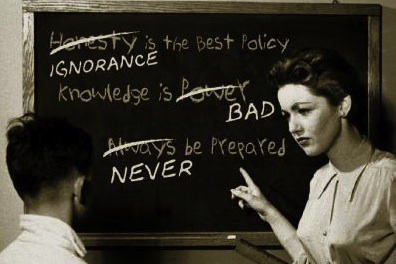 Most of the posts that appear on this site are either thoughts, beliefs, or other things that come from my mind or things that I encounter/happen to be a part of my life. This post came my way via Facebook and as I read it I could not only agree with Pete Sheehan.
Most of the posts that appear on this site are either thoughts, beliefs, or other things that come from my mind or things that I encounter/happen to be a part of my life. This post came my way via Facebook and as I read it I could not only agree with Pete Sheehan.
I’ve experienced cuts to many of the programs I worked in or managed but when one door closes it takes creativity and the desire to keep the opportunity available for the children. To me, the closing of science and technology programs in my district sends the message that the powers that be, regardless if the decision is made at the local, district, or state level, don’t want our children to have access these academic skills or career options which as the image shows will keep them unaware of these skills or careers.
This image caught my eye and in too many ways it does seem to echo the state of STEM programs in many of our schools. Yes, Knowledge is power but ignorance is bliss. Ignorant in the Webster definition meaning unaware. Keep the knowledge from the masses and they won’t have a clue. Share it with a select group however, and they will be in the position of power. You can believe they aren’t cutting science and technology at many private schools or even public schools where parents, communities, and even teachers are finding funding to have solid STEM education in their schools.
There was a time when I and the populations I work with were intentionally kept from attaining knowledge. If children become knowledgeable then as they grow up they will seek innovative ways to change the world and that’s the frightening or bad aspect which is the most saddening part of the science and technology funding cuts. Lastly, if we don’t prepare them with the knowledge because we don’t require them to be prepared as students then we won’t prepare them to work in STEM careers. Sheehan asks, “Who will run the coal plants or energy plants of the future if we don’t prepare young people today?”
That’s a good question. Children are our future and if we listen to the words of the song we should teach them well and let them lead the way. The conversation I don’t believe people are having is what future are we preparing them to lead or better yet, are we preparing them for being contributory, responsible adults who will be able to step in our shoes and keep moving society forward?
Education is in crisis, violence in our communities continues, and in the case of my city, is escalating. We aren’t talking about strengthening academics or addressing the social/emotional needs of so many of our students and since these are the issues our current school leaders and politicians are focusing on, finding ways to increase, not cut, science and technology programs is a mere aside.
Sheehan raises some good points in his article which includes asking if the future of our society will be run by a generation of illiterates who will have no technical knowledge. Hmmmmm, makes one stop and think. It touched me deep enough that I decided to share it here on my site. You can read Sheehan’s article, that appeared in The Journal on August 18 and add your comments on The Journal’s site. I would be interested in hearing what others think about his assessment of the state of science and education funding by commenting here as well.
I’m with him in asking seriously, “What the hell is wrong with these people?”
Funding science and education
Science and Technology
August 18, 2012 – Pete Sheehan
Read comments | Post a comment
There was an article in the news recently about plans to cut funding for a number of observatories and research centers, including the NRAO in Green Bank, West Virginia, where a friend of mine was recently doing an internship.
When I read about plans to cut funding for science and education (which is frequently), I have to ask a question:
What the hell is wrong with you people?
“Well they haven’t shown any results, we have more important things to spend money on.”
and
“The education system wastes tons of money. We have more important things to spend money on!”
No. No, we do not have more important things to spend money on. Nothing could possibly be more important than science and education. It actually pains me to say it, science advocate that I am, but education is the most important, with science being a second.
There could not possibly be anything more important than ensuring the next generation has the knowledge to take over running the world. Putting a bunch of funding into coal mining or whatever so we have enough fuel to run things doesn’t help us if the next generation is a bunch of illiterates who can’t run a coal processing plant. This isn’t an argument, it is an objective fact. If you think the world continuing to run after we pass on matters – which, unless you’re a hell of a nihilist, you pretty much have to – then absolutely nothing is more important than making sure the next generation is prepared, by educating them.
The only situation I can imagine that would supersede education funding would be if the world was LITERALLY on the brink of disaster. Having a generation of idiots is moderately better than the world descending into chaos or blowing up or what have you.
But aside from that, no, education should be our top priority. It isn’t throwing money away, it is investing in the future. Passing on our knowledge to the next generation is what allows society to flourish. The phrase “We stand on the shoulders of giants” sums it up nicely. No matter how clever a scientist might be, we are NOTHING without the cumulative knowledge of those who came before us. The development of sophisticated language, and, eventually, record-keeping techniques is what made humans dominant on Earth.
It might be a chimpanzee figured out how to make a bow and arrow at one point, but lacking a formal language, he couldn’t very well pass on the information very well, could he? That idea died with him. Or maybe chimps do have a formal language, I don’t know. Its an example.
Each new generation of creators doesn’t have to start over from scratch, we work with all the knowledge and technology of those who came before us, from the first simple tools of our prehuman ancestors, to the more sophisticated techniques of the egyptians, right up to the industrial revolution. Without these forefathers, we wouldn’t be at this point, where new discoveries involve absurdly sophisticated machines like the Large Hadron Collider, rather than the ease of just thinking up new ideas like our forefathers might have enjoyed. (I have often reflected it would have been much easier to be an inventor a hundred years ago or so. There weren’t so many ideas already taken.)
Speaking of inventing, that brings me to the next most important object of funding: Science.
NASA brought us televisions when they had to develop communication systems for space missions. This wasn’t their goal, it was a side benefit that benefitted all of society. Countless scientific discoveries happen independent of the actual goal of a project, and there is absolutely no way of predicting what benefits might be gained from a project (not to mention the direct benefits gained from the actual goal of a project). It is irresponsible, and downright IMMORAL to cut science funding.
The GPS devices that have become so common nowadays actually take advantage of part of Einstein’s Theory of General Relativity to function. He thought of the idea on his own (supposedly), but countless hours of research and documentation went into proving it, and eventually taking advantage of it.
Where would we be if his funding had been cut because oh, he hasn’t put out anything useful in a few years? Who needs science funding, all they do is piddle around in labs all day.
I’ll tell you where we would be, we’d be got-dang LOST because we wouldn’t have a GPS.
The problem is, the people who decide whether funding goes to science often don’t UNDERSTAND the things they are choosing not to fund. I’ve said it before and I’ll say it again – and you can call me elitist if you wish – nonscientists aren’t qualified to even comment on high-level scientific endeavors, let alone decide if they should be funded or not.
The people in charge of these things talk like the scientists want funding for these projects for selfish reasons, but there is no nobler endeavor than a scientific one. By definition, they expand the sum of human knowledge.
And you know what? Knowledge is all we, as a people, have.
Sure, there’s art, religion, music, what have you, but if you look at human history, the quality of these things fluctuate, the cultural output of a people varies wildly.
But you know what has had a direct growth throughout all of human existence (well, except during the Dark Ages, but they’re called dark for a reason.)? Knowledge. Science. Technology. And that has a direct correlation with quality of life, length of life, and what we can DO with our lives. Without science, our society would be nothing. We’d be animals. In fact, we wouldn’t have lasted at all. Humans are useless without science, the fundamental ability to make tools – technology – is the only advantage we have over other creatures, and its the only reason the first primate to develop a bigger brain rather than bigger muscles didn’t get wiped out immediately by a bigger, stronger creature.
The reason science has direct growth throughout human history (exponential growth, in fact. See the Law of Accelerating Returns and works by Ray Kurzweil) is that it, unlike other factors of human culture which fluctuate, is objective. Art, music, etc are all subjective, but science is empirical. There are a set of objective, key, logical facts about which there is no arguing. Logic is the basis of science, making empirical observations which can be used to be implemented with technology.
A caveman finds a stick with a sharp, broken end.
“Oh, this stabs into things easier than a blunt stick. I can use this to kill things better.”
“Oh, but it breaks easily. Its only good for one stab. But if I break another stick, I can make another one!”
“Its becoming hard to keep finding good sticks for this. Hm, this rock is much harder than wood, and the broken edge is even sharper. It’ll last much longer. I’ll take this thin vine and use it to secure the rock to the stick!”
The invention of the spear.
THAT is humanity. That’s all we are, and its all we’re good for. The continuing progress of technology allows us to get better and better at surviving (though this long progressed past getting better at killing things so we can eat their meats). An outlying evolutionary trend happened to work extraordinarily well, and had no end in sight for how far it can progress.
(Some view the growth of technology as us taking over where evolution left off. We used to evolve biologically, but now our culture – our species, in fact – evolves technologically.)
So when people suggest that the growth of science isn’t important and doesn’t merit funding, it disgusts me. Science is the ONLY thing we’re good for, it is the reason for our existence, and it is objectively THE greater good of humanity. But instead they want to give more money to politicians and oil barons.
What the hell is wrong with you people?
Congratulations from President Obama
President Barack Obama congratulates the NASA JPL MSL/Curiosity rover team and brings his own unique brand of comedy to his message by recognizing the NASA “Mohawk” guy and Curisoity’s search for “Martians.” He also thanked JPL for helping to inspire young people around the world to see how cool STEM (Science, Technology, Engineering, and Mathematics) can really be!
Here’s the complete transcript of the call!
DR. ELACHI: Good morning, Mr. President.
THE PRESIDENT: Who am I speaking with?
DR. ELACHI: This is Charles Elachi, the director of JPL. And we have a room full of the mission operation personnel. This is “Curiosity” Mission Operation on Mars.
THE PRESIDENT: Well, it is great to talk to all of you. And I just want you to know that we could not be more excited about what you’ve been doing.
Somebody asked me the other day whether you’ve already found Martians. (Laughter.) I told them we have to give you a little bit of time. But we know you’re all hard at work and you’re getting some well-deserved rest after a successful landing. And I just wanted to call and say congratulations to the entire Mars Science Laboratory team, and really all of JPL, on last Monday’s incredible success.
Through your dedicated efforts, “Curiosity” stuck her landing and captured the attention and imagination of millions of people not just across our country, but people all around the world, including Times Square. And what you did on Mars was incredibly impressive. Those 76 pyrotechnics going off in perfect succession and the 500,000 lines of code working exactly the way you guys had ordered them — so it’s really mind-boggling what you’ve been able to accomplish. And being able to get that whole landing sequence to work the way you did is a testimony to your team.
I especially want to congratulate Charles Elachi, the head of JPL; the entry descent and landing lead, Adam Steltzner, who helped devise the final step of this amazing descent — the Sky Crane System. What you’ve accomplished embodies the American spirit, and your passion and your commitment is making a difference. And your hard work is now paying dividends, because our expectation is that “Curiosity” is going to be telling us things that we did not know before and laying the groundwork for an even more audacious undertaking in the future, and that’s a human mission to the Red Planet.
I understand there’s a special Mohawk Guy that’s working on the mission. (Laughter.) He’s been one of the many stars of the show last Sunday night. And I, in the past, thought about getting a Mohawk myself — (laughter) — but my team keeps on discouraging me. And now that he’s received marriage proposals and thousands of new Twitter followers, I think that I’m going to go back to my team and see if it makes sense. (Laughter.)
DR. ELACHI: That’s going to be the new fashion at JPL. (Laughter.)
THE PRESIDENT: It does sound like NASA has come a long way from the white shirt, black dark-rimmed glasses and the pocket protectors. (Laughter.) You guys are a little cooler than you used to be. (Laughter.)
As all of you know, my administration has put a big focus on improving science and technology, engineering and math education. And this is the kind of thing that inspires kids across the country. They’re telling their moms and dads they want to be part of a Mars mission — maybe even the first person to walk on Mars. And that kind of inspiration is the byproduct of work of the sort that you guys have done.
So not only do I want to congratulate the team, I want to call out a few of the leaders of the group, including Adam, but also Peter Theisinger, Richard Cook, John Grotzinger, John Grunsfeld. And I’d like to congratulate and thank all of our international partners — Spain, Russia, Germany, France, Canada, Italy, Japan, Australia — all of them contributed, I know, to the instrumentation “Curiosity” landed on Martian surface — and all the scientists who are part of the JPL team.
So you guys have done an outstanding job. You made us all proud. You’ve made NASA proud. You guys are examples of American know-how and ingenuity, and it’s really an amazing accomplishment. So we can’t wait to start hearing back from “Curiosity” and finding out what’s going on. We’re fortunate to be part of a society that can reach beyond our planet and explore frontiers that were only imagined by our ancestors. So it’s inspiring to all of us.
I’m going to give you guys a personal commitment to protect these critical investments in science and technology. I thank you for devoting your lives to this cause. And if, in fact, you do make contact with Martians, please let me know right away. (Laughter.) I’ve got a lot of other things on my plate, but I suspect that that will go to the top of the list. (Laughter.) Even if they’re just microbes, it will be pretty exciting. (Laughter.)
DR. ELACHI: Well, thank you, Mr. President. And on behalf of all us at NASA, we thank you for taking the time to give us a call. And, hopefully, we inspired some of the millions of young people who were watching this landing. Thank you again.
THE PRESIDENT: Well, you’ve already inspired us, but I know that the photographs that are going to start coming back are going to be remarkable and amazing. And, again, you guys should be remarkably proud. Really what makes us best as a species is this curiosity that we have and this yearning to discover and know more, and push the boundaries of knowledge. And you are perfect examples of that, and we couldn’t be more grateful to you.
So, congratulations. Keep up the great work.




